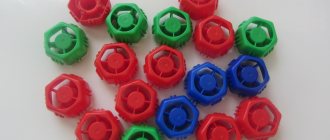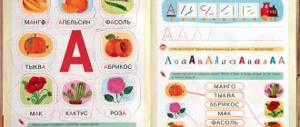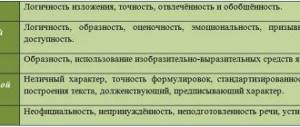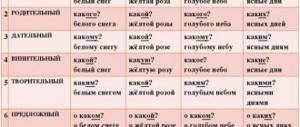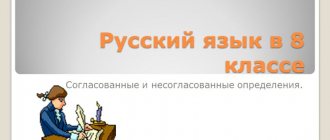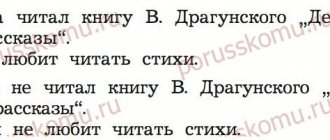- home
- Directories
- Handbook of Russian for elementary school
- Sounds and letters
- Consonant sounds and letters representing them
- Soft and hard consonants
Consonants can be hard or soft .
Many consonants are paired in softness-hardness , i.e. in different words they can soften or become hard. In transcription, the softness of a consonant is indicated by the [ ' ] symbol.
Table of consonant sounds, paired and unpaired by hardness/softness:
| Consonant clusters | Doubles | Unpaired |
| Solid | [b], [c], [d], [d], [h], [k], [l], [m], [n], [p], [p], [s], [t ], [f], [x] | [zh], [w], [ts] |
| Soft | [b'], [c'], [g'], [d'], [z'], [k'], [l'], [m'], [n'], [p'], [p'], [s'], [t'], [f'], [x'] | [th'], [h'], [h'] |
In writing, the hardness of consonant sounds is indicated by the vowels a, o, u, ы, e (which come after the consonant sound) - park [ park], rota [ rota ] , puma [ puma ], kry nka [little jar], s er [sir].
The softness of consonant sounds in writing is indicated by:
- soft sign - shallow [ m'el'], pal that [pal'to], written [ p'is'm'eny']
- vowels e, e, i, yu, i - p e n [p'en'], sv e kla [sv'okla], p i t [p'it'], k l u in [kl'uv], pl i ska [pl'aska].
In addition, consonant sounds paired in hardness/softness can be softened before some soft consonants - z [z'] , s [s'] , n [n'] , t [t'] , l [l'] .
For example: pes n ya [p'es'n'a], es l i[y'es'l'i], tail ik [khvos't'ik] and others.
Also, the consonant [n'] will be soft before the consonant letters ch and shch , while a soft sign is not written between them: donut [pon'ch'ik], racer [gon'sch'ik].
Remember that consonants unpaired in hardness-softness remain only hard or only soft (regardless of whether there is a soft sign after them or what vowel follows them).
Hard unpaired consonants always remain hard.
For example:
[zh] - heat [heat], yellow [yellow']
[sh] - ball [ball], sew [shy'u]
[ts] - heron [heron], circus [circus]
Soft unpaired consonants always remain soft.
For example:
[th'] - yogurt [y'ogurt], my [my']
[h'] - hour [h'as], check [ch'ek]
[sch'] - pike [sch'uka], gap [sch'el']
Share with friends on social networks:
Paired hard and soft consonants
Most consonants form pairs with each other based on hardness/softness. There are 15 such pairs in modern Russian.
Each letter of the Russian alphabet corresponds to paired hard and soft consonant sounds:
| Letter | Solid sound | Soft sound |
| b | [b] | [b'] |
| V | [V] | [V'] |
| G | [G] | [G'] |
| d | [d] | [d'] |
| h | [h] | [z'] |
| To | [To] | [To'] |
| l | [l] | [l'] |
| m | [m] | [m'] |
| n | [n] | [n'] |
| P | [P] | [P'] |
| R | [R] | [R'] |
| With | [With] | [With'] |
| T | [T] | [T'] |
| f | [f] | [f'] |
| X | [X] | [X'] |
Using paired hard and soft consonants, words of different meanings are distinguished:
- languid - dark;
- soap - cute;
- bow - hatch.
In written speech, after hard consonants the letters “a”, “o”, “u”, “e”, “y” are written, and after soft consonants - “e”, “e”, “i”, “yu”, “ya” " and "ь".
Consonant sounds soft and hard
When a child learns that there are 21 consonant letters in the Russian language, and remembers each of them (b, v, g, d, zh, z, j, k, l, m, n, p, r, s, t, f, x, ts, ch, sh, shch), you can safely tell him that there are hard and soft consonants.
Always soft and hard consonants
Let's start with exceptions. There are always soft consonants that never become hard, no matter what letter follows them. There is also their exact opposite: always hard consonants , which do not want to become softer.
Thus, you can draw a table with your first grader that will help him remember that there are sounds that do not vary in softness/hardness. Allow your child to keep it in front of his eyes the first time he completes tasks until he remembers the contents of the table well.
Always soft(despite the presence of the letters a, o, y, s, e behind them) | Always solid(despite the presence of the letters i, yu, i, e, ё or a soft sign behind them) |
| [H'], [Sh'], [Y'] | [C], [F], [W] |
How soft sounds are formed in Russian
Softness consonants receive:
- if followed by a soft sign, for example, LION CUB ([l']);
- in cases where after a consonant (except always hard ones) there are vowels such as E, Yo, I, Yu, I, for example, BUFFIN ([n'], [g']), HONEY ([m']), PEOPLE ([l']), BALL ([m']).
Before proceeding further, check whether the student remembers 3 important rules:
- only the sound, not the letter, can be soft or hard,
- how to determine softness or hardness by vowel,
- Do all soft consonants have hard pairs?
For example, ask your child: Is H a soft or hard consonant in the words SCARECROW and MAN?
How hard consonants are formed in Russian
Sounds become hard when they are:
- before a solid sign, for example, ENTRANCE ([d]);
- before the vowels A, O, U, Y, E: DOLL ([k], [l]), SMOKE ([d]), HOUSE ([d]);
- before another consonant: CAKE ([p]);
- and also at the end of a word, if the sound is not one of those that is always soft: BALL ([r]).
Table of hard and soft consonants
For better perception and memorization, you should work on pairs of words with opposite sounds
Ask: Which consonants are soft and which are hard? To begin with, you should use auxiliary tables.
| [b] - [b'] | ball - squirrel |
| [in] - [in'] | wolf - fork |
| [g] - [g'] | year - weight |
| [d] - [d'] | home - kids |
| [z] - [z'] | umbrella - winter |
| [k] - [k'] | cat - whale |
| [l] - [l'] | lotto - summer |
| [mm'] | flour - bowl |
| [n] - [n'] | nose - bottom |
| [p] - [p'] | dust - dog |
| [r] - [r'] | genus - series |
| [s] - [s'] | rash - network |
| [t] - [t'] | pelvis - shooting range |
| [f] - [f'] | background – eagle owl |
| [x] - [x'] | move - hit |
A first grader must remember that a sound is soft or hard, since it is followed by a certain vowel.
Theory
Well, now let's move on to a specific theory. Hard consonants - a table that will consist of two parts. The first thing you need to remember is that the hardness or softness of a sound is determined by its neighboring vowel. When a letter is followed by a, o, y, s , then the sound it denotes will definitely be hard (mitten, stomp, lips, played), and if there are e, e, yu, i, and , the consonant will sound softer ( blizzard, dog, mint, Kiev). Thus, we can say that there is no point in memorizing all hard consonants. Almost all of them are paired. This property was shown in the first row of words, where we learned to distinguish between hard and soft sounds. Therefore, everything depends on this very vowel.
Hard and soft consonants
How to teach a child to distinguish soft sounds from hard ones? We must start with the fact that softness and hardness are characteristics only for consonant sounds. The vowels here are in the chorus. Although hardness and softness are not typical for them, it is their close proximity in some words that can affect these properties of consonant sounds. The main difference between soft and hard sounds is the peculiarities of their pronunciation.
If a person pronounces soft consonant sounds, then the middle of his tongue rises to the palate and blocks the passage through which the air moves, and the tip moves slightly forward towards the teeth. This is additional articulation. The process itself is called palatalization.
Kids don’t need to know such complexities, but parents may find this term useful to broaden their horizons. This does not happen when pronouncing solid sounds.
To understand the difference yourself, it is enough to say a test word in which the same sound acts as a hard and soft sound.
Let's take "break" as an example. Pronunciation of the first consonant sound [p'] makes the tongue dance in the mouth and rise to the sky, but for the second consonant sound [p] these somersaults are not needed.
It’s easy for parents to understand the difference, but how can you explain it to a child? We suggest using your imagination and using interesting stories, cheat sheets and simple games that will help kids remember hard and soft consonant sounds.
How many sounds are there in Russian?
First of all, the child must learn that all letters, except for the soft and hard signs, represent certain sounds. The Russian language has 33 letters but 42 sounds. While learning the alphabet, you need to help your child remember that the Russian language has vowels and consonants. One letter can represent two sounds. Below is a list of letters along with the number of sounds each one represents.
Total 33 letters:
- 10 vowels: a, u, o, s, i, e, i, yu, e, e;
- 21 consonant letters: b, v, g, d, g, z, j, k, l, m, n, p, r, s, t, f, x, c, ch, w, sch;
- The signs ь and ъ are letters that do not have sounds.
Total sounds - 42:
- 6 vowels: [a], [o], [u], [i], [s], [e];
- 36 consonants: [b], [b'], [c], [v'], [g], [g'], [d], [d'], [g], [z], [z' ], [th'], [k], [k'], [l], [l'], [m], [m'], [n], [n'], [p], [p' ], [p], [p'], [s], [s'], [t], [t'], [f], [f'], [x], [x'], [ts] , [h'], [w], [w'].
A table where all the vowels and consonants of letters and sounds are collected
Hard and soft signs
It is important to explain to the first grader that neither b nor b have anything to do with vowels or consonants. They are only helpers, making a consonant soft or hard.
| Kommersant | Has no sound! It can only appear between a consonant and a vowel, as in the word “entry”. It is used to show that the consonant before it is hard. |
| b | Has no sound! Indicates the softness of the consonant preceding it. |
Another useful table of sounds and letters
Auxiliary features of hard and soft consonants
A certain combination of organs of the articulatory apparatus is responsible for the pronunciation of each sound. Children can be taught how to easily recognize the hardness and softness of consonants by the position of their lips.
If, while pronouncing a syllable, a child smiles, that is, the corners of his lips move to the sides, then such a syllable contains a soft sound. If, when pronouncing a syllable, you don’t want to have fun, then on the contrary, it’s hard. This will make learning soft and hard sounds easier and more fun.
How to teach a child to distinguish between hard and soft sounds
What sound comes after a consonant:
- If after a consonant there is a vowel a, o, u, e, s, then the consonant is hard.
- If after a consonant there is a vowel and, e, yu, i, then the consonant is soft.
Practice with examples: In the words “mother” and “nora” the consonants are hard, because they are followed by “a” and “o”. In the words “fly” and “nanny” the consonants are soft because they are followed by “e”, “i”, “ya”.
- If another consonant sounds after a consonant, then the first consonant will be hard.
- There are sounds that can only be hard and sounds that can only be soft, no matter what sound is heard or what letter is written after them.
Always hard sounds - zh, sh, ts. Always soft - th, h, shch. A common way to learn these sounds is a simple technique: we write the letters that convey these sounds on a line, and emphasize “th, ch, sch.” The underscore symbolizes the cushion on which the soft sounds sit. The pad is soft, which means the sounds are soft.
Voiced and unvoiced sounds
Consonant sounds are also classified into voiced and voiceless. The former consist of voice and noise, while the latter consist only of noise.
The voiced category includes: [B], [G], [D], [F], [Z], [V], [Y], [L], [M], [N], [R].
The deaf group includes: [К], [П], [Х], [Ц], [Ч], [С], [Т], [Ф], [Ш], [Ш].
Most consonants can form pairs based on deafness and hardness:
[B]—[P] [V]—[F] [D]—[K] [D]—[T] [G]—[S] [W]—[W]
Voiceless and voiced consonants are easy to remember using two sentences:
- “The Lion and the Toad Have Many Friends” (Voiced)
- “Styopka, do you want a cheek? - Ugh!" (Deaf).
You can memorize them or print them out on a separate card.
